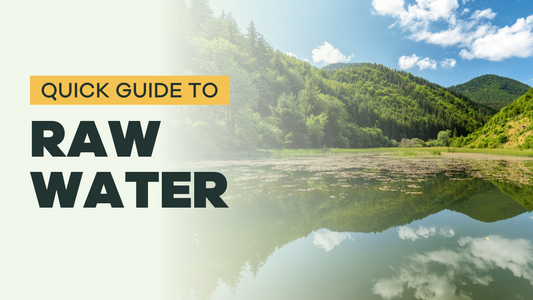The Complete Guide to Discolored Tap Water
Our blog is written by real experts— not AI. Each guide is carefully reviewed and updated based on the latest research. Plus, with no affiliate links, you can count on unbiased insights you can trust.
In this complete guide to discolored tap water, you’ll learn what different tints and colors mean —including cloudy ice and stains on clean laundry—and what to do about it.
Running your faucet and seeing discolored water—yellow, brown, green, murky, milky or oily—can be alarming. But while changes to the color of your tap water can indicate different problems along the line, discolored water does not necessarily suggest your water is dangerous to drink.
Table of Contents:
- Why Is My Tap Water Yellow or Orange?
- Brown or Murky?
- Green or Blue?
- Cloudy or White?
- Look Oily?
- Does Discolored Water Affect My Laundry?
- Is Discolored Water Safe to Drink?
- When Should I Test My Discolored Water?
- What's the Takeaway?
Why Is My Tap Water Yellow, Orange (or Red-Brown)?
Iron in your water supply is the most likely cause for yellow or orange, rusty colored water. There are two kinds of iron in water supplies:
- Ferrous (“clear water”) iron: Water will come out of your faucet clear but tint yellow-orange while sitting over time
- Ferric (“red water”) iron: Water comes out of your faucet red-orange or rusty looking
Iron can get into your tap water for a number of reasons, including water utility maintenance, rusty piping, or issues affecting your well. But getting down to the precise source of your water’s yellow or orange discoloration depends on a couple factors:
- Is your tap water yellow only momentarily or does it remain yellow?
- Does your water come from a municipal water system or does it come from a private well?
Most of the time, yellow, orange, or red-brown tap water is still safe to drink and bathe in, it just might not appear too appealing.
If Your Yellow or Orange Tap Water Clears Up
If your yellow, orange, or rust-tinted tap water clears up (like after a first draw—the first cups of water that come out of your faucet after sitting undisturbed for a few hours), the likely culprit is your plumbing:
Corroded Faucets
Over time, the inside of faucets can rust away. Dislodged pieces of rust can tint your water yellow, orange or even brown. The easiest way to test the suspected faucet is to pour a glass of water from a different faucet and compare the color.
Rusty Household Plumbing
Old pipes tend to accumulate rust, especially if your plumbing is made from outdated materials like galvanized steel. Rust-tinted water would likely flow out of every faucet. It’s a good idea to contact a professional plumber to confirm whether or not your plumbing system is rusting from the inside out.
Rusty Water Heater
If only hot water is yellow (or orange or brown), your water heater could be releasing small amounts of rust into your water supply. Try another faucet, with only the cold water running, and compare the two glasses side by side.
Orange or Yellow Tap Water from City or Utility
If your tap water comes from a municipal water supply, here are a couple common causes of yellow or orange water:
- Your utility is performing repairs: Repair work upstream may loosen rust, sediment, or other particles in the network that enter your water supply
-
Your utility is “flushing” the lines: In order to clear out stagnant areas of the water system, suppliers occasionally increase water pressure in pipes and mains. During this flushing process, yellowish rust particles are loosened within the pipes.
-
- If only cold water is coming out yellow (or orange or brown), it is highly likely the utility has recently flushed the lines.
-
Public utilities are required to filter iron in water systems down to at least 0.3 PPM, according to the Environmental Protection Agency’s (EPA) Secondary Drinking Water Standards.[1]
We recommend calling your utility to confirm maintenance is being performed, particularly if the yellowing does not clear up after running the tap for some time.[2]
If maintenance is not being performed, and your tap clears up after the first few moments, the culprit could be your plumbing (see above).
Orange or Yellow Well Water
If your tap water comes from a private well, there are a handful of possibilities to consider:
Iron build-up
Iron is the most common cause of orange or yellow well water, especially if the water tastes metallic. Most often, iron builds up in well groundwater supplies together with manganese. Exposed to oxygen, ferrous iron will react and turn water yellow, orange, or even reddish-brown.
-
-
- Iron, in the form of orange sediment, will settle at the bottom of a glass of water left out overnight.
- Iron leaves yellow-orange stains on your fixtures, while manganese can leave behind black staining or sludge.
- Treatment options include cation exchange, oxidizing filters (including greensand filters), and oxidation and filtration.
-
Iron-related Bacteria
Iron (and manganese) bacteria are small organisms that naturally occur in soil and water. They are not known to cause disease but they can turn your water yellow. By combining iron or manganese with oxygen, these bacteria can produce a yellowish, slimy buildup, or even an oily sheen (more on that below).[3]
Tannins
Tannins are byproducts of natural fermentation processes that occur when water passes through peaty soil or decaying organic matter, tinting your water yellow. Tannins are likely the culprit if your yellow water tastes bitter and smells somewhat musty. Tannins can be removed by activated carbon filtration and anion exchange. Tannins are not harmful to your health.
We recommend testing your well water at least annually. But because everyone’s water profile is unique—especially when it comes to wells—it’s important to test your water before attempting to treat it.
Yellow water can come from a variety of sources, few of which render your water unsafe to drink. If you’re still uncertain, you can test for yellow or orange water specifically.
Why Is My Tap Water Brown or Murky?
Tap water that has turned a brown or murky color is usually the result of sediment. While sediment itself is not unsafe to drink per se, it can be generally unpleasant and may stimulate bacteria growth.
Note: Brown water can also be mistaken for rusty water, or water with high amounts of iron in it (the longer water sits unused in rusted pipes, the deeper the discoloration), in which case see the section above.
Murky or Brown City or Utility Water
If you’re on municipal or city water, maintenance or utility issues (like a broken water main, use of a nearby fire hydrant, or construction work) can cause changes in flow, as with yellow water above, that disturb naturally-occurring sediments that exist in all water systems.[2] Switching water sources (like from a reservoir to a river) can also cause these kinds of changes.
Calling your utility to investigate is usually the best first line of action when you notice abrupt changes to your water quality, like brown or murky water.
Murky or Brown Well Water
Sediment is one of the most common well water contaminants. Gravel, sand, or silt can all make their way into your well water, giving it a yellow or even brown, murky tinge. Excess sediment in your water supply can also point to larger issues with your well:
- Issues with your well pump can occur if excess sediment has accumulated
- Broken or degraded well screens can allow excess sediment into your well water, which, as mentioned, can stimulate bacterial growth
Generally, brown, murky water as a result of sediment is easy to spot. A sediment filter is a good treatment option if sediment is a problem.
How to Spot Well Water Contamination
Why Is My Tap Water Green or Blue?
Although quite rare, green or blue water may be either the result of algal growth or extreme copper corrosion.
It’s best to avoid drinking green or blue water.
Algae
Algal growth is a concern for those who source their water from a private well. During the warm weather months, algae can grow in water sources (including lakes, streams, reservoirs, wells, and even pipes), turning the water a greenish color.
At high concentrations, algae in environmental waters can accumulate to form unpleasant “pond scum,” and in some cases, decay can release a foul odor.[4] Algae-affected drinking water can cause a wide range of undesirable health effects, from mild to toxic.
Shock chlorination of your well is the recommended course of action against algal growth. But it’s a good idea to test your water before committing to any treatment.
Cyanobacteria enumeration tests help identify and quantify the presence of blue-green algae from harmful algal blooms.
Copper Corrosion
Water that is blue or green in color is the result of copper corrosion, which also causes bluish-green staining around fixtures and on surfaces. It’s usually the result of extreme corrosion, which is a rare occurrence (and sometimes exacerbated by household electrical systems that are grounded to copper pipes).[2]
While ingesting copper from your drinking water at low doses is not harmful to your health, it’s best to avoid consuming water that clearly suggests copper corrosion. Have a professional plumber inspect your plumbing system as soon as possible if you notice the changes mentioned above.
Potential treatment options include pH adjustment (if needed for corrosion control), cation exchange and reverse osmosis.
Why Is My Tap Water Cloudy or White?
Cloudy or milky white water is most commonly caused by air bubbles, though that’s not always the case.
Sometimes total suspended solids (TSS), hard water, and even methane gas can cause tap water to appear white, milky, or cloudy.
If Your Cloudy Water Clears Up
Your water is cloudy due to air bubbles. The air in your pipes is under pressure. When you turn on the faucet, this pressure is released. If you allow a cloudy glass of water to sit, the bubbles should rise and clear from the bottom up. These tiny air bubbles are completely harmless.
You may run into air bubbles more often in cold weather because more air dissolves into cold water than warm water. Recent plumbing work or changes in pressure can also lead to excess air trapped in your water.
If Your Cloudy Water Does Not Clear Up
It is more likely your water has a greater amount of solids in it. (This does not necessarily mean your water is unsafe to drink.) Causes of lingering cloudy water include:
Total Suspended Solids (TSS)
TSS is a measure of the concentration of small particles in water that do not dissolve. Your glass will not clear up after sitting for a little while and it may look like particles are moving in there.
High levels of TSS—not to be confused with Total Dissolved Solids or TDS—can be caused by runoff or recent disturbances such as drilling, construction, maintenance, or major storms near your water supply. (As mentioned above, sediment from soil or around your well can also turn your water brown.)
-
-
-
Sediment is not necessarily a health concern, but high concentrations can lead to bacteria growth. A sediment filter is a good treatment option if sediment is a problem.
-
Sediment is not necessarily a health concern, but high concentrations can lead to bacteria growth. A sediment filter is a good treatment option if sediment is a problem.
-
Hard Water
Hard water, or water with high levels of dissolved calcium and magnesium, typically leaves a grayish-white film around faucets, fixtures, and glassware. Very hard water can make your water cloudy. Precise levels of hard water varies by region.[5] A water softener, typically a cation exchange filter, will reduce water hardness.
Methane Gas
By far the rarest, but most dangerous, circumstance, trapped methane gas is more likely to affect well owners. Methane gas will make your water cloudy and will sputter, bubble, or spurt as it comes out. If you suspect you have methane gas in your water, be sure to:
-
-
- Thoroughly ventilate the area. Methane is both odorless and flammable.
- Do not drink the water and have it tested right away.
-
Is Cloudy Ice Safe to Drink?
Yes, cloudy ice is safe to drink. Cloudy ice is most often caused by dissolved gasses—mainly nitrogen and oxygen—trapped during the freezing process.
Hard water can also cause cloudy ice cubes, due in large part to the same minerals we covered above.
You can test specifically for a broad array of metals and minerals in drinking water that can cause hard water and have troubling impacts on your plumbing or health.
Why Does My Tap Water Look Oily?
The most common culprit of household water with an oily sheen is iron bacteria.
Often this sheen or slime on the surface of your water is rainbow or oil-like in appearance. It can give off a swampy or musty smell, which is more pungent if the water has not been used in a while.[3]
Note: Iron bacteria should only be a problem for well owners. As mentioned above, these bacteria combine iron (and manganese) with oxygen to make rust deposits. They also create a slime that can clog your well system.
How Can I Prevent Iron Bacteria Build-up?
Iron bacteria has to enter your well to become a problem. Iron bacteria live on the ground outside. Here are some tips to prevent build-up:
- Make sure your well casing is capped, watertight, and extends 1 foot above ground.
- Avoid placing pumps, pipes, or any well pieces on the ground while making repairs.
- Disinfect your well, pump, and plumbing after repairs.
- Never use anything but disinfected water for drilling, repair, or priming pumps.
A more serious problem could be petroleum contamination. If you suspect petroleum products (oil or gasoline) have contaminated your water supply, you’ll likely know by the smell.
Cease use of the water and have your water tested for petroleum-related contamination as soon as possible.
Does Discolored Water Affect My Laundry?
Water quality issues—like temporarily discolored water—can have a marked impact on your clean laundry. Here is a list of common water stains and what they could mean about your water quality:
Hard Water Stains
Again, due to the high levels of calcium and magnesium, hard water can lead to poor performance of soaps and detergents and leave stains on your freshly laundered clothing. Problems often attributed to hard water include:
- Graying or yellowing
- General soil buildup
- Stiffer feel to fabrics
- White or gray streaks on colored fabrics
Laundry detergents (especially powdered ones) tend to attach to the calcium and magnesium in hard water. Often, you’ll find you have to use more detergent and higher water temperatures to get the level of cleanliness you’re looking for. Solutions to doing laundry with hard water include:
- Opting for liquid detergents over powered ones
- Adding ½ cup of laundry borax to each load
- Soaking your clothes in 1 cup of distilled vinegar mixed with 1 gallon of water for 30 minutes. Rinse, then launder.
- Installing a water softener
Rust-Related Stains
Rusty water, or water with high levels of iron in it, can also lead to stains like:
- Yellow, red or brown spots on clothing
- White clothing turned dingy or drab
Here are a three tips to remove rust-related stains:
- Try a commercial rust remover in your laundry cycle. The acid in these products combines with the iron to loosen it from the fabric and suspends it in the water. Tip: Use an extra rinse cycle to remove any remaining acid
- Avoid chlorine bleach—chlorine will set stains in permanently
- Don’t throw your rust-stained clothes in the drier. The heat will set stains in permanently
Mold-Related Stains
While often mistaken for a water-related issue, Serratia marcescens, commonly known as “pink mold,” is a bacteria that thrives in warm, dark, damp conditions. Naturally, it loves washing machines.
As the name suggests, “pink mold” can leave pink blotches and discoloration on your clothes. To remove, try the following in a well-ventilated area:
- Dip a sponge in a diluted solution of 2 tablespoons of color-safe bleach and 1 quart water
- Blot the stain gently
- Let rest for 10 minutes
- Launder. Tip: Leave your washer door open after use to let it dry out
Copper-Related Stains
As we mentioned above, excessive copper corrosion that begins to turn water blue-green is rare. But in the event it happens, you can be sure it will leave blue-green stains on your laundry.
Moisture and increased temperatures both cause copper to oxidize more quickly. The longer you leave stains in, the deeper they settle into the fabric. While you can use a vinegar or chemical cleaner to lessen the stain, copper stains are the most challenging to remove.
Is Discolored Water Safe to Drink?
As mentioned above, discolored water is most likely safe to drink even if it looks unpleasant.
While it’s a good idea to try and remedy the situation as soon as possible, discolored water is not a health concern unless you’re dealing with:
- Yellow or rusty water from corroded galvanized pipes, as discoloration may be accompanied by other harmful contaminants, like lead.
- Blue or green water. It’s best to avoid drinking water that is contaminated with algae or is discolored from severe copper corrosion.
- Water that is cloudy white and bubbly as a result of methane gas.
- Water with an oily sheen that smells of petroleum products.
When Should I Test My Discolored Water?
It’s never a bad idea to test your water, especially when your quality has undergone sudden, visible changes—like color changes. Well owners in particular should pay close attention to any changes in their water quality, especially as the season’s change and different weather or industrial events occur in your area.
Can You Filter Discolored Water?
Yes, there are ways to filter out discoloration from your water. But if it’s not a momentary issue, like public utility maintenance or a change in water source, it’s a much better idea to seek out and fix the source of discoloration—e.g. If you have yellow or orange water from rusted pipes or fixtures, you should consider replacing the corroded components.
If the solution to your problem can’t be found by speaking to a utility or a plumbing expert, you should have your water tested before considering a treatment method to better understand your water’s unique quality profile.
Consider these helpful tests if you’re concerned with changes in your water’s color or quality:
Essential Home Water Test
Basic testing panel for water utility customers or private well owners concerned primarily by metals, bacteria, aging pipes, and infrastructure.
Advanced Home Water Test
Ideal baseline for testing tap water provided by a water utility utilizing chlorine disinfection or a private well near areas of heavy agriculture or industry. Test your drinking water for some of the most common concerns found in tap water.
Also: This specialized Biofilm Bacteria Water test targets pesky iron related bacteria (IRB), sulfate reducing bacteria (SRB), and slime forming bacteria in drinking water—all in one kit! These three common bacteria are responsible for an array aesthetic (taste, color, odor) issues, as well as biofilms and other slimy buildup on fixtures and surfaces:
The Best Water Testing Kits of 2025
What's the Takeaway?
- While changes to the color of your tap water can be an indicator of different problems somewhere along the pipe network, discolored water does not necessarily suggest your water is dangerous to drink
- Discolored water could be a health concern if you’re dealing with:
- Blue or green water.
- Cloudy white and bubbly water as a result of methane gas.
- Water with an oily sheen that smells of petroleum products.
- Testing your water will help you isolate the root cause of discoloration—filtration shouldn’t be relied upon as a remedy until you know the source of your discoloration.
Interested in our other blogs on aesthetics?
The Ultimate Tap Water Odor Guide
The Ultimate Tap Water Taste Guide
















